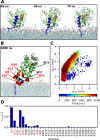Membrane Binding of Recoverin: From Mechanistic Understanding to Biological Functionality
- PMID: 28852701
- PMCID: PMC5571466
- DOI: 10.1021/acscentsci.7b00210
Membrane Binding of Recoverin: From Mechanistic Understanding to Biological Functionality
Abstract
Recoverin is a neuronal calcium sensor involved in vision adaptation that reversibly associates with cellular membranes via its calcium-activated myristoyl switch. While experimental evidence shows that the myristoyl group significantly enhances membrane affinity of this protein, molecular details of the binding process are still under debate. Here, we present results of extensive molecular dynamics simulations of recoverin in the proximity of a phospholipid bilayer. We capture multiple events of spontaneous membrane insertion of the myristoyl moiety and confirm its critical role in the membrane binding. Moreover, we observe that the binding strongly depends on the conformation of the N-terminal domain. We propose that a suitable conformation of the N-terminal domain can be stabilized by the disordered C-terminal segment or by binding of the target enzyme, i.e., rhodopsin kinase. Finally, we find that the presence of negatively charged lipids in the bilayer stabilizes a physiologically functional orientation of the membrane-bound recoverin.
Conflict of interest statement
The authors declare no competing financial interest.
Figures




Similar articles
-
Structure, topology, and dynamics of myristoylated recoverin bound to phospholipid bilayers.Biochemistry. 2003 Jun 3;42(21):6333-40. doi: 10.1021/bi0206816. Biochemistry. 2003. PMID: 12767213
-
Phosphatidylserine Allows Observation of the Calcium-Myristoyl Switch of Recoverin and Its Preferential Binding.J Am Chem Soc. 2016 Oct 19;138(41):13533-13540. doi: 10.1021/jacs.6b04218. Epub 2016 Oct 11. J Am Chem Soc. 2016. PMID: 27689444
-
Structure and calcium-binding studies of a recoverin mutant (E85Q) in an allosteric intermediate state.Biochemistry. 2002 May 7;41(18):5776-87. doi: 10.1021/bi012153k. Biochemistry. 2002. PMID: 11980481
-
Portrait of a myristoyl switch protein.Curr Opin Struct Biol. 1996 Aug;6(4):432-8. doi: 10.1016/s0959-440x(96)80106-0. Curr Opin Struct Biol. 1996. PMID: 8794166 Review.
-
Dimerization of Neuronal Calcium Sensor Proteins.Front Mol Neurosci. 2018 Nov 2;11:397. doi: 10.3389/fnmol.2018.00397. eCollection 2018. Front Mol Neurosci. 2018. PMID: 30450035 Free PMC article. Review.
Cited by
-
Zebrafish Recoverin Isoforms Display Differences in Calcium Switch Mechanisms.Front Mol Neurosci. 2018 Sep 28;11:355. doi: 10.3389/fnmol.2018.00355. eCollection 2018. Front Mol Neurosci. 2018. PMID: 30323742 Free PMC article.
-
Interaction of MRI Contrast Agent [Gd(DOTA)]- with Lipid Membranes: A Molecular Dynamics Study.Inorg Chem. 2024 Jun 17;63(24):10897-10914. doi: 10.1021/acs.inorgchem.4c00972. Epub 2024 May 25. Inorg Chem. 2024. PMID: 38795015 Free PMC article.
-
Effects of Membrane and Biological Target on the Structural and Allosteric Properties of Recoverin: A Computational Approach.Int J Mol Sci. 2019 Oct 10;20(20):5009. doi: 10.3390/ijms20205009. Int J Mol Sci. 2019. PMID: 31658639 Free PMC article.
-
The Binding Properties and Physiological Functions of Recoverin.Front Mol Neurosci. 2018 Dec 20;11:473. doi: 10.3389/fnmol.2018.00473. eCollection 2018. Front Mol Neurosci. 2018. PMID: 30618620 Free PMC article. Review.
-
Bringing the Ca2+ sensitivity of myristoylated recoverin into the physiological range.Open Biol. 2021 Jan;11(1):200346. doi: 10.1098/rsob.200346. Epub 2021 Jan 6. Open Biol. 2021. PMID: 33401992 Free PMC article.
References
LinkOut - more resources
Full Text Sources
Other Literature Sources

